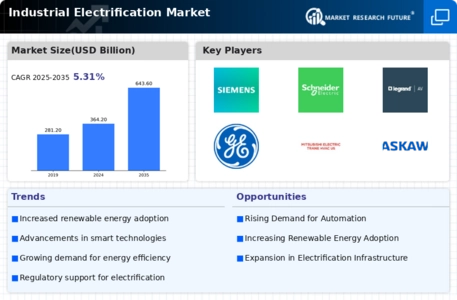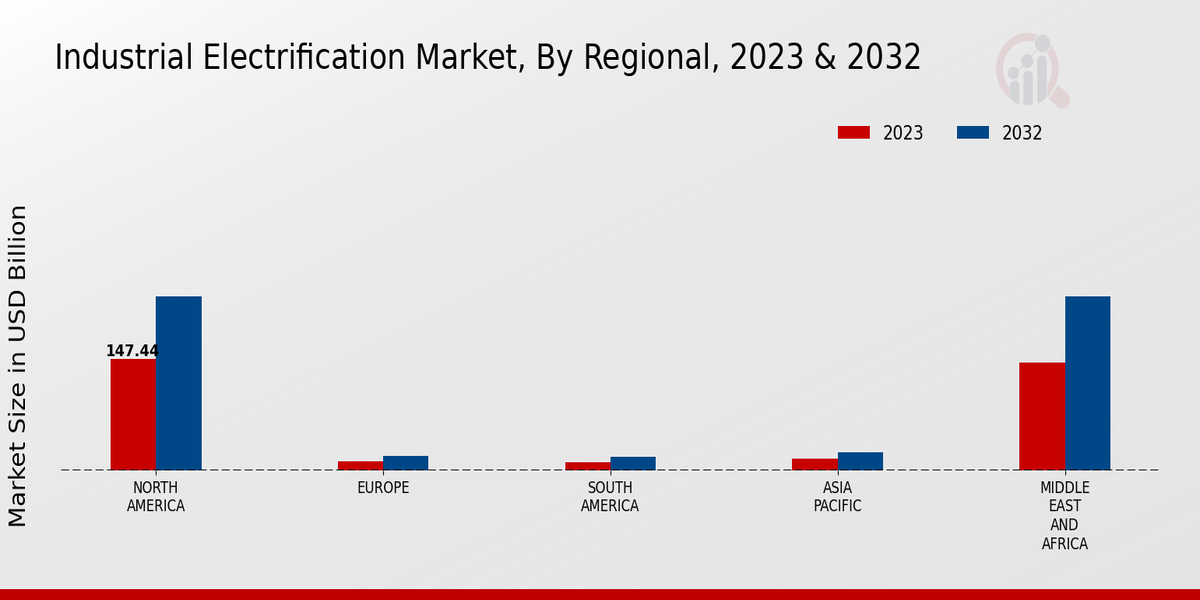Market Growth Projections
The Global Industrial Electrification Market Industry is projected to experience substantial growth over the coming years. With a market value of 364.2 USD Billion in 2024, it is anticipated to reach 643.6 USD Billion by 2035. This growth trajectory reflects a compound annual growth rate (CAGR) of 5.31% from 2025 to 2035. Such projections indicate a robust demand for electrification solutions across various industrial sectors, driven by the need for energy efficiency, sustainability, and technological advancements. The market's expansion is likely to create new opportunities for stakeholders and contribute to the overall transformation of industrial processes.
Increasing Industrial Automation
The trend of increasing industrial automation is a key driver in the Global Industrial Electrification Market Industry. Automation technologies, such as robotics and artificial intelligence, require reliable and efficient power sources, making electrification essential. Industries are investing in electrification to support automated processes, which can lead to improved productivity and reduced operational costs. This trend is likely to continue, with the market expected to reach 643.6 USD Billion by 2035, as more industries recognize the benefits of integrating electrification with automation solutions.
Government Initiatives and Policies
Government initiatives play a crucial role in shaping the Global Industrial Electrification Market Industry. Various countries are implementing policies to promote electrification as part of their energy transition strategies. For example, the European Union has set ambitious targets for reducing greenhouse gas emissions, which encourages industries to adopt electrification technologies. These policies often include financial incentives, grants, and subsidies for electrification projects. As a result, the market is likely to witness significant growth, with an anticipated value of 643.6 USD Billion by 2035, driven by supportive regulatory frameworks.
Rising Demand for Energy Efficiency
The Global Industrial Electrification Market Industry experiences a notable surge in demand for energy-efficient solutions. Industries are increasingly adopting electrification technologies to reduce energy consumption and operational costs. For instance, the implementation of electric motors and drives can enhance efficiency by up to 30 percent compared to traditional systems. This trend is expected to contribute to the market's growth, with projections indicating a market value of 364.2 USD Billion in 2024. As industries strive to meet sustainability goals, the shift towards electrification becomes a pivotal strategy for achieving energy efficiency.
Shift Towards Renewable Energy Sources
The shift towards renewable energy sources significantly influences the Global Industrial Electrification Market Industry. As industries seek to reduce their carbon footprint, the integration of renewable energy into electrification strategies becomes essential. Solar, wind, and hydroelectric power are increasingly being utilized to electrify industrial processes. This transition not only aligns with global sustainability goals but also enhances energy security. The growing reliance on renewables is expected to propel the market forward, contributing to a projected market value of 364.2 USD Billion in 2024, as industries embrace cleaner energy alternatives.
Technological Advancements in Electrification
Technological advancements are a driving force in the Global Industrial Electrification Market Industry. Innovations in electric equipment, such as advanced power electronics and smart grid technologies, enhance the efficiency and reliability of electrification solutions. For instance, the integration of Internet of Things (IoT) technologies allows for real-time monitoring and optimization of energy usage in industrial settings. This not only improves operational efficiency but also supports sustainability efforts. As industries increasingly adopt these advanced technologies, the market is projected to grow at a CAGR of 5.31% from 2025 to 2035, reflecting the ongoing evolution of electrification solutions.














